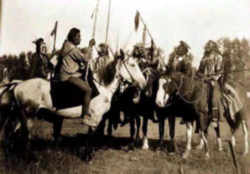


Montana Symbols
Montana Early History
First Early Inhabitants of Montana

Early history examines the archaeological record that tells the story of the first inhabitants of Montana. Learn about the prehistory and culture of the first early inhabitants, and what lessons it might teach us about the early history of Montana.
Montana First Early Inhabitants Timeline
- 570Mil BP-230Mil BP - In northern Alberta is the Peace River Arch; the Transcontinental Arch extends from Minnesota to Arizona and in Montana is the Montana Dome. The Ozark Mountains lie on the site of a dome and from Nashville, Tennessee, north to Michigan lies the Cincinnati Arch. Between Peace River, north-west Canada, and Montana and occupying much of Saskatchewan is the Williston Basin. Michigan lies four-square upon the Michigan Basin, while much of Illinois and Indiana is underlain by the Illinois Basin. Most of these broad, gentle features developed during Paleozoic time and have been dormant ever since. (DD-EVTT, p.172)
- 150Mil BC - Fossils of a sauropod named Suuwassea emileae (ancient thunder) were found in southern Montana in 1998. It was about 50 feet long and related to Diplodocus. (SFC, 5/21/04, p.A2)
- 150Mil BC - In 2005 archeologists in Montana worked to unearth a sauropod believed to be from this time making it about twice as old as most dinosaur skeletons found in the state. It seemed to represent a missing link in the evolution of the sauropods. (AP, 7/22/05)
- 80Mil BC - Hadrosaurs such as Brachylophosaurus Canadensis lived in Montana. Biochemical evidence from a fossilized femur later suggested an evolutionary link of such duck-billed dinosaurs to birds. (SFC, 5/5/09, p.A8)
- 80Mil BC - Upper Cretaceous Lance Formation in Montana, Wyoming and S. Dakota has fossils of Pachycephalosaurus (thick-headed lizards). They stood on two feet and were herbivorous. They had a dome-like development on the skull made of solid bone, most likely used in combat as a battering ram. It stood 5m and had spikes on its nose and around the back of its skull. (TE-JB, p.91)(Econ, 10/27/12, p.81)
- 68Mil BC - Fossils of a Tyrannosaurus rex from this time were found in the Hell Creek formation of Montana in 2003. In 2005 scientists reported that a femur contained soft tissue. In 2007 researchers sequenced amino acids in the tissue and reported that they matched those of modern chickens. Some sequences matched those of a newt, a frog and several other animals. In 2008 researchers said modern bacterial colonies had infiltrated cavities in the bone. (SFC, 3/25/05, p.A2)(SFC, 4/13/07, p.A6)(SFC, 7/31/08, p.A15)
- 2,000,000-20,000 BC - Series of glacial ice sheets cover portions of Montana.
- 640000BC - Volcanic eruptions in northwest Wyoming, extending to Idaho and Montana, created a caldera some 40 miles long and 30 miles wide. The surface collapsed thousands of feet into a magma pool and marked the area later known as Yellowstone. Continuing eruptions caused climactic changes around the world. (SFEC, 10/18/98, p.T5)(HC, 10/10/06)
- 15000BC-13000BC - During the last Ice Age dams of glacial meltwater repeatedly failed and eroded land in southeastern Washington state and Oregon. This exposed petrified logs in what later became Gingko Petrified Forest State Park. An ice dam, which blocked the Clark Fork River in Montana and created lake Missoula, broke at least 40 times and caused cataclysmic floods. One Missoula flood left Portland under 400 feet of water. (CW, Fall '03, p.20)(SSFC, 9/12/04, p.D9)
- 15,000-13,000 BC - Asiatic people migrate over land bridge to Montana.
- 8,000-6,500 B.C. - Prehistoric people develop communal hunting techniques in Montana.
- 6,500 BC-1,500 AD - Prehistoric people populate all areas of Montana.
- c1000 - Polychromatic rock drawings were made at Weatherman Draw, also known as the Valley of the Chiefs. [see Apr 23, 2002] (SFC, 6/22/01, p.A7)
- 1803 - The United States bought the Louisiana Territory from France for 15 million dollars for the land
- 1805 - Choctaw and northern (Chickasaw and Cherokee) Indian cessions open up land to white settlement during 1805 - 1806
Early History of Native Americans in Montana
The Indigenous People of Montana
The names of the Montana tribes included the Arapaho, Arikara, Assiniboine, Atsina, Cheyenne, Chippewa, Cree, Crow, Dakota, Hidatsa, Kalispel, Kiowa (see above picture), Kutenai, Mandan, Nez Perce, Piegan, Salish (Flathead), Tunahe and the Spokane.
The first inhabitants of the area now known as Montana were nomadic people who followed the mammoth and the buffalo and gathered plants. Although some tribal people believe their ancestors have lived in the northern Rocky Mountain region since the world began, archaeologists believe the first inhabitants crossed the Bering Strait from Asia around 12,000 years ago. There is evidence of a thriving culture living west of the Rocky Mountains as early as 9,000 years ago.
Before the white settlers arrived, two groups of Indian tribes lived in the region that is now Montana. The Arapaho, Assiniboine, Atsina, Blackfeet,
Cheyenne, and Crow tribes lived on the plains. The mountains in the west were the home of the Bannack, Flathead, Kalispell, Kootenai, and Shoshone
tribes. Other nearby tribes (such as the Sioux, Mandan, and Nez Perce) hunted in the Montana region. When the first white traders came west, there
may have been as many as 15,000 people belonging to the Blackfeet Nation living in this area.
Each of these tribal cultures worshipped all sources of life and believed the earth was sacred. Their contact with white traders and the introduction
of guns and horses into these societies changed them forever and made them dependent upon trade for their existence. Their use of horses for hunting
made them much more efficient in killing the bison upon which they lived, but may also have led to the near extinction of these animals.





